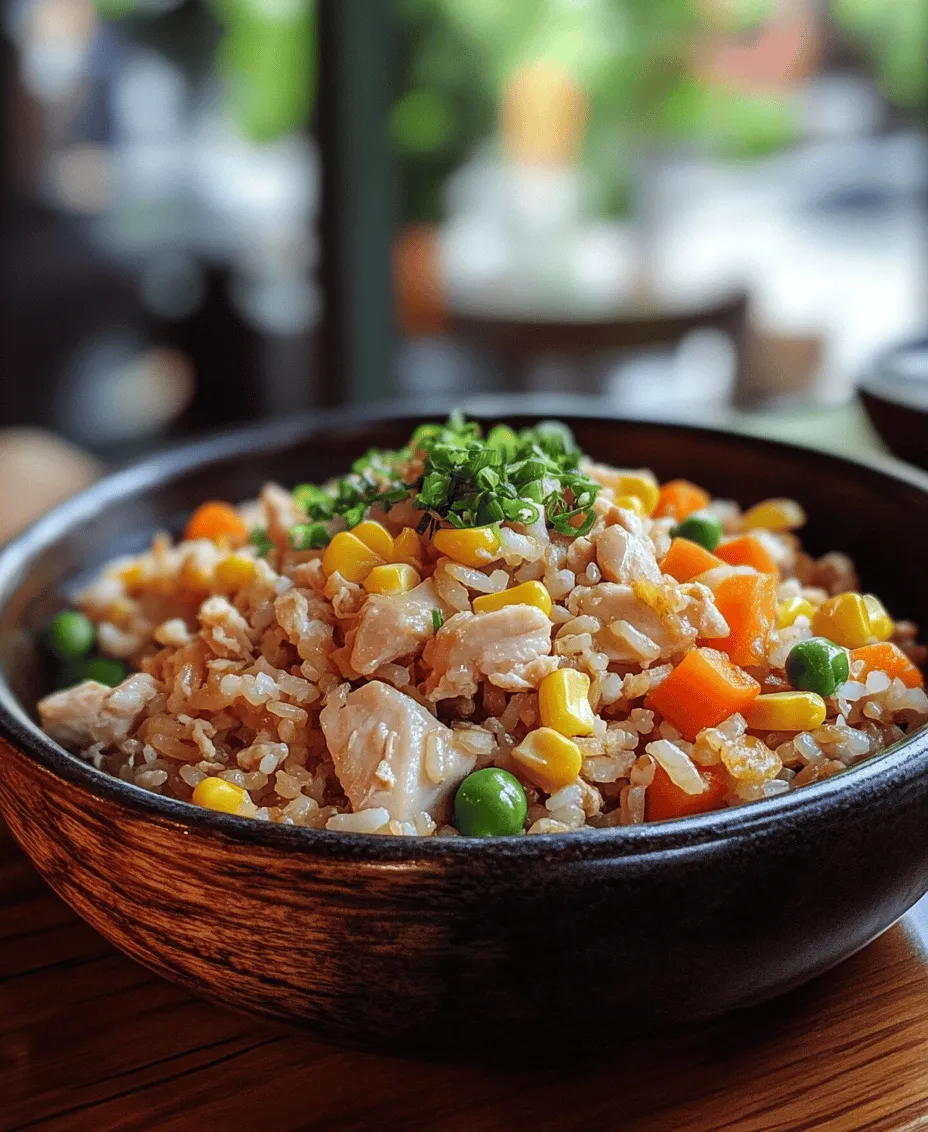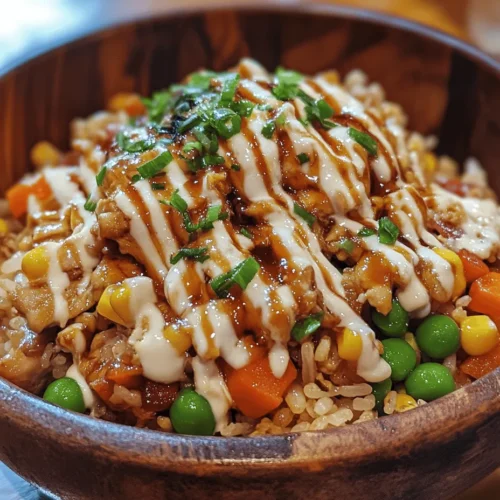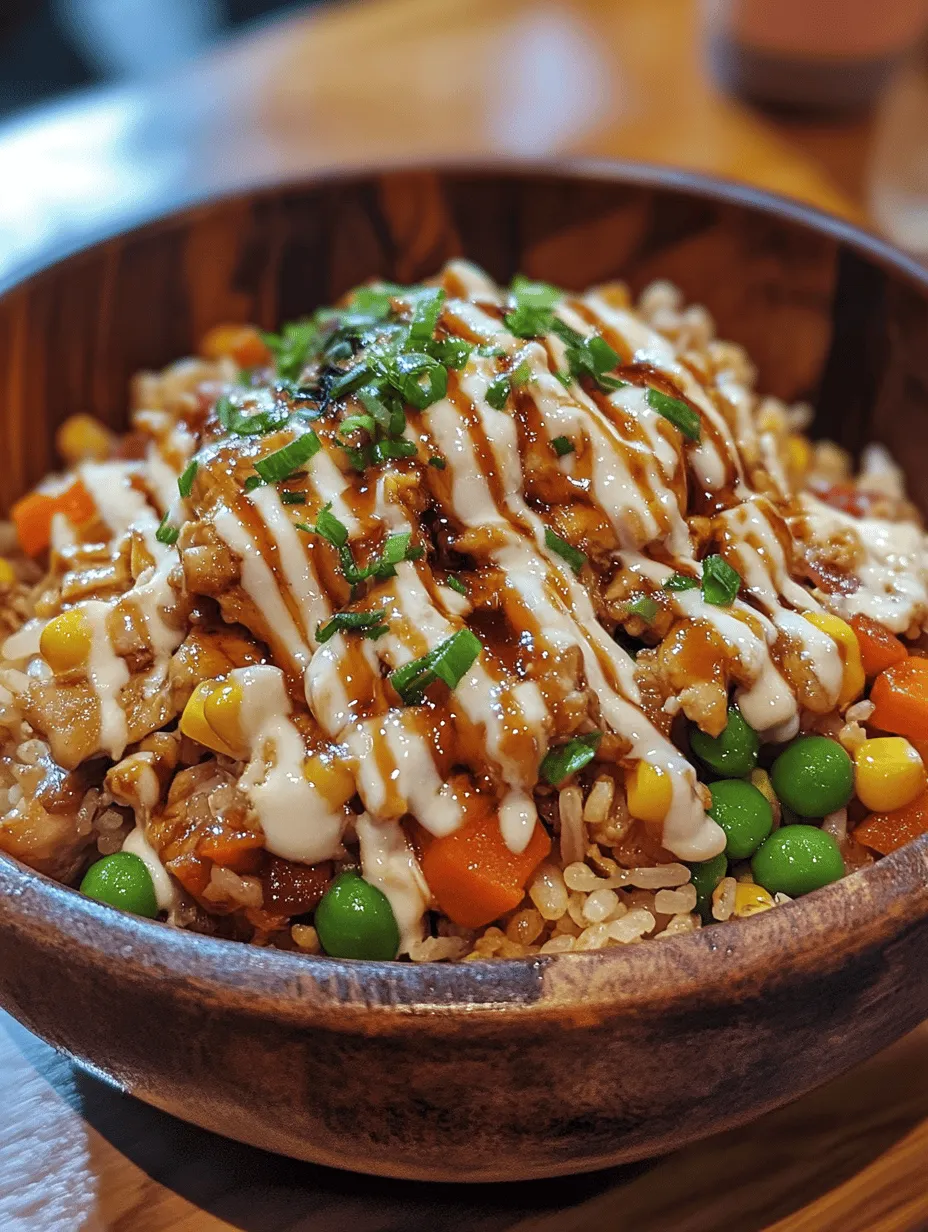Introduction
Delve into the vibrant world of homemade cuisine with our Restaurant-Style Chicken Fried Rice recipe. This beloved dish embodies the essence of Asian cooking, offering a delightful blend of flavors and textures that will tantalize your taste buds. Perfectly seasoned chicken, colorful vegetables, and fluffy jasmine rice come together in a harmonious symphony, making this dish a favorite among families and foodies alike.
Chicken fried rice is not just a meal; it’s an experience that evokes the aromas of bustling Asian kitchens and the warmth of shared family dinners. Whether you’re an experienced home cook or a beginner in the kitchen, this guide will walk you through the steps to create a restaurant-quality chicken fried rice right in your own home. By mastering this dish, you’ll not only impress your family and friends but also gain a deeper appreciation for the art of cooking.
Understanding the Essence of Fried Rice
Exploring the Origins of Fried Rice
Fried rice has a rich and storied history that traces back to ancient China, where it was created as a way to use leftover rice and other ingredients, thereby minimizing waste. The concept of stir-frying rice likely dates back to the Sui Dynasty (581–618 AD), but it wasn’t until the Tang Dynasty (618–907 AD) that it became more popularized as a dish.
As the dish traveled through various cultures, it evolved into numerous regional adaptations, each with its unique twist based on local ingredients and culinary traditions. From the savory, soy-sauced variations found in Chinese cuisine to the spicy versions in Thai cooking, fried rice has transformed into a beloved global staple. Today, it is enjoyed in countless forms and remains a go-to dish for many households, thanks to its versatility and the joy it brings to the dining table.
The Key Ingredients of Chicken Fried Rice
To achieve authentic flavors in your chicken fried rice, it is essential to understand the role that each ingredient plays in the overall dish. The balance of flavors and textures is what sets restaurant-style fried rice apart from homemade attempts. Let’s take a closer look at the key components that make this dish a standout.
– Jasmine Rice: Jasmine rice is the best choice for fried rice due to its fragrant aroma and slightly sticky texture. This long-grain rice remains fluffy when cooked, allowing each grain to separate easily during stir-frying. The subtle floral notes of jasmine rice enhance the overall dish, making it a delightful base for the savory ingredients.
– Chicken Breast: The lean protein that enhances the dish. Chicken breast is favored for its tender texture and ability to absorb flavors. When marinated and cooked properly, it brings a satisfying bite to the fried rice, complementing the other ingredients beautifully.
– Mixed Vegetables: Adding a rainbow of mixed vegetables not only enhances the visual appeal of the dish but also contributes vital nutrients. Fresh vegetables like peas, carrots, and bell peppers offer crunch and sweetness, while frozen options provide convenience without sacrificing flavor.
– Eggs: Eggs play a crucial role in adding richness and texture to chicken fried rice. They are typically scrambled and mixed into the rice, creating an indulgent creaminess that binds the dish together.
– Soy Sauce and Sesame Oil: These flavor powerhouses are essential for achieving the signature taste of fried rice. Soy sauce adds umami depth and saltiness, while sesame oil introduces a nutty richness that enhances the overall profile of the dish.
– Garlic and Green Onions: The aromatic elements that elevate the dish. Garlic provides a pungent, savory depth while green onions add a fresh, mildly peppery flavor. Together, they contribute to the aromatic foundation essential to any great fried rice.
Ingredients Breakdown
Now that we understand the significance of each ingredient, let’s break down the list of components you’ll need to prepare our Restaurant-Style Chicken Fried Rice.
Highlighting the Main Ingredients
1. Jasmine Rice (3 cups, cooked and cooled): Using day-old rice is ideal for frying, as it helps prevent clumping.
2. Chicken Breast (1 pound, diced): Boneless, skinless chicken breast is recommended for a lean protein option.
3. Mixed Vegetables (1 cup): A blend of peas, carrots, and bell peppers works well; feel free to use fresh or frozen.
4. Eggs (2 large): These will be scrambled and mixed into the rice.
5. Soy Sauce (4 tablespoons): Choose low-sodium soy sauce for a balanced flavor.
6. Sesame Oil (2 tablespoons): This will enhance the overall flavor profile of your dish.
7. Garlic (2 cloves, minced): Fresh garlic is key for that aromatic base.
8. Green Onions (2 stalks, sliced): These will be used for garnish and added flavor.
Preparation Steps for Restaurant-Style Chicken Fried Rice
Step-by-Step Cooking Instructions
Creating the perfect restaurant-style chicken fried rice requires a bit of preparation and organization in the kitchen. Here are the initial steps to set yourself up for success:
1. Prepare Your Workspace: Before you start cooking, ensure your kitchen is organized. Gather all the ingredients and utensils you will need, including a large wok or frying pan, a spatula for stirring, and a cutting board for chopping.
2. Cook the Rice: If you haven’t already prepared your jasmine rice, cook it according to the package instructions. Once cooked, spread the rice out on a baking sheet to cool. This helps to dry out the rice and prevents it from becoming mushy during cooking.
3. Marinate the Chicken: In a medium bowl, combine the diced chicken breast with a tablespoon of soy sauce, a dash of sesame oil, and a pinch of salt and pepper. Allow the chicken to marinate for at least 15 minutes to absorb the flavors.
4. Prep the Vegetables: If you’re using fresh vegetables, wash and chop them into small, uniform pieces. If using frozen, simply measure out the amount needed and set aside.
5. Beat the Eggs: In a small bowl, crack the eggs and beat them until they are well mixed. This will ensure a smooth consistency when scrambled.
These preliminary steps lay the foundation for a successful chicken fried rice dish that not only looks appealing but also bursts with flavor. In the next section, we will continue with the cooking process, where you will bring all these components together in a delicious, satisfying meal. Stay tuned as we guide you through the remaining steps to achieve that ideal restaurant-style outcome.

Cooking Techniques
Achieving the perfect restaurant-style chicken fried rice requires a combination of precise cooking techniques that enhance flavor and texture. Here, we will explore the proper heat levels and sautéing methods to create a delicious meal.
Utilizing Proper Heat Levels for Optimal Results
The heat level is crucial when making fried rice. Ideally, you want to use high heat to achieve that signature smoky flavor known as “wok hei.” This is the essence of the dish, imparting a slightly charred aroma that elevates the overall taste. Here are some key points to consider:
1. Preheat Your Pan: Ensure your wok or frying pan is adequately preheated before adding any ingredients. A hot surface will help sear the chicken quickly, preventing it from becoming rubbery.
2. Cook in Batches: If you are making a large quantity, consider cooking the chicken and vegetables in batches. This prevents overcrowding in the pan, allowing each piece to sear properly rather than steam.
3. Adjust Heat as Needed: While high heat is essential for frying rice, you may need to lower it slightly when adding sauces or delicate ingredients like eggs to avoid burning.
Sautéing: The Art of Achieving the Perfect Chicken and Egg Scramble
Sautéing is a fundamental technique in preparing chicken fried rice. The goal is to ensure the chicken is cooked thoroughly while the eggs remain fluffy and perfectly scrambled. Here’s how to do it right:
1. Cooking the Chicken: Start by adding a bit of oil to your hot pan, followed by the diced chicken. Stir-fry until the chicken is golden brown and cooked through, about 4-5 minutes. Remove the chicken from the pan and set it aside.
2. Scrambling the Eggs: In the same pan, add a little more oil if necessary, and crack the eggs directly into the center. Stir quickly to scramble and break the yolks, cooking for about 1-2 minutes until they are just set. The key is to not overcook the eggs; they should remain soft and fluffy.
3. Combining Ingredients: Return the cooked chicken to the pan with the eggs, and mix them well. This ensures the flavors meld and that every bite contains chicken and egg.
Mixing Ingredients: Tips for Ensuring Even Distribution of Flavors
Even distribution of flavors is essential for a harmonious fried rice dish. Here are some techniques to ensure every bite is as flavorful as the last:
1. Add Ingredients in Phases: When adding vegetables like peas, carrots, and green onions, do so in phases. Start with those that take longer to cook, such as carrots, and then add more delicate vegetables like peas at the end.
2. Use a Gentle Folding Technique: Instead of stirring vigorously, use a gentle folding technique to mix the rice and ingredients. This helps prevent the rice from breaking down and becoming mushy.
3. Season as You Go: Incorporate sauces and seasonings gradually. Start with soy sauce, and taste as you go to ensure the flavors are balanced without overwhelming the dish.
—
Cooking Tips for Perfect Fried Rice
Achieving the Right Texture
The texture of your fried rice can make or break the dish. Here are essential tips to ensure the right consistency:
The Importance of Day-Old Rice
Using day-old rice is one of the most critical steps in making fried rice. Freshly made rice contains more moisture and tends to clump together, leading to a soggy dish. Here’s why day-old rice is beneficial:
– Drier Grains: Refrigerated rice dries out, resulting in grains that are separate and firm. This texture allows for easy frying without clumping.
– Enhanced Flavor: Day-old rice has had time to absorb flavors, making it even more delicious when stir-fried with sauces and other ingredients.
Avoiding Soggy Rice
To prevent your fried rice from becoming soggy, consider these key factors during cooking:
1. Rinse the Rice: If you have to use fresh rice, rinse it under cold water until the water runs clear. This removes excess starch, reducing the likelihood of clumping.
2. Spread Out Fresh Rice: If using freshly cooked rice, spread it out on a baking sheet and let it cool for a bit to help reduce moisture before incorporating it into your dish.
3. Control the Liquid: Be mindful of the amount of soy sauce and other liquids you add. Start with smaller amounts and gradually increase, tasting as you go.
Flavor Enhancements
Optional Add-Ins: Exploring Variations Such as Shrimp or Tofu
While chicken is a classic choice for fried rice, don’t hesitate to experiment with different proteins or even go vegetarian. Some great options include:
– Shrimp: Quick-cooking and packed with flavor, shrimp can be added to the pan after the chicken has been removed. Cook until just pink and then set aside before mixing in with the rice.
– Tofu: For a vegan option, cube firm tofu and pan-fry until golden. Tofu absorbs flavors beautifully and provides a wonderful texture contrast.
Balancing Flavors: Tips for Adjusting Seasoning According to Taste
Flavor balance is essential in fried rice, and here are tips to achieve it:
1. Taste as You Go: Regularly taste your dish throughout the cooking process. This allows you to adjust seasonings like soy sauce, salt, and pepper to suit your palate.
2. Add Fresh Herbs: Incorporating fresh herbs like cilantro or basil at the end can elevate the dish with a burst of freshness.
3. Consider Acid: A splash of lime or lemon juice right before serving can brighten the flavors and add a delightful zing.
—
Nutritional Insights
Understanding the Nutritional Value
Chicken fried rice is a well-rounded dish that offers a balance of protein, carbohydrates, and vitamins. Here’s a breakdown of the health benefits of some of the key ingredients:
– Chicken: A great source of lean protein, chicken helps with muscle repair and growth. It also contains essential nutrients like B vitamins, which are vital for energy production.
– Vegetables: The addition of vegetables like peas, carrots, and green onions provides essential vitamins and minerals. For example, carrots are rich in beta-carotene (vitamin A), while peas offer fiber and vitamin K.
– Rice: As the base of the dish, rice is primarily a source of carbohydrates, providing energy. Opting for brown rice can enhance the nutritional profile by adding more fiber and nutrients.
This dish can be easily customized to meet dietary preferences or restrictions, making it a versatile addition to your meal rotation.
—
Serving Suggestions
Pairing Your Fried Rice
To create a well-rounded meal, consider serving your chicken fried rice with complementary dishes. Here are a few ideas:
1. Soups: A light broth-based soup, such as hot and sour soup or miso soup, can pair beautifully with fried rice, offering a contrast in flavors and temperatures.
2. Salads: A simple cucumber salad dressed with rice vinegar and sesame oil adds a refreshing crunch that balances the richness of the fried rice.
3. Spring Rolls: Crispy vegetable or shrimp spring rolls can serve as an excellent appetizer, adding texture and flavor variety to your meal.
—
Conclusion
Mastering the art of chicken fried rice allows you to bring a taste of the restaurant experience into your kitchen. With its simple yet flavorful profile, this dish is not only easy to prepare but also a crowd-pleaser. Whether it’s a weeknight dinner or a special gathering, this recipe stands as a testament to the joy of cooking and sharing delicious meals with loved ones.
Embrace the vibrant flavors and textures of homemade chicken fried rice, and enjoy the culinary adventure it brings to your dining table. With the right techniques, ingredient choices, and serving suggestions, your fried rice will not only satisfy your cravings but also impress your family and friends. Dive into this delightful dish and discover why it has remained a favorite in kitchens worldwide.


